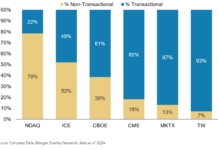
A sophisticated analysis of trading impact, total cost and the market ecosystem is imperative to the success of a buy-side fixed income trading desk, said Daniel Leon, global head of Trading & Securities Financing at AXA Investment Managers, opening the FILS summit in Barcelona.
“Our clients are looking for us to help them make sense of this fragmented market,” he said. “This is how we are going to be the top trading desk. The key point is that the market is extremely splintered and there are so many elements that can impact a trade, we must be able to address them.”
The level of complexity that firms face in assessing the costs of trading and the value they generate for clients has become significant, due to the range of instruments and protocols that must be navigated. Traders also need to comprehend the underlying causes behind the metrics that allow them to analyse their activity.
“You need to understand when the repo market is going to affect you, you need to know when derivatives will move and the cash will not move,” he said. “You need to know what is the best way to put a meaningful trade together for your clients.”
Leon gave the example of his firm’s trading team analysis of their execution quality. Based against the mid-price in the market found they were saving 64% of the bid-offer spread. However they were a better seller than they were a buyer. This was largely as a result of size bias, as sell trades are typically smaller, along with quantitative easing – with the European Central Bank (ECB) as a buyer – and the cost of trades on sell-side balance sheets, which was also significant.
The firm also conducted an analysis of its repo market activity, fearing that the withdrawal of dealer balance sheet would potentially close the market to them. This did not happen, despite the impact of the leverage ratio, part of the Basel II capital adequacy rules which meant that repo was 100% of cost on the bank balance sheet.
“At the same time that regulation was making repo very expensive … cash at the bank level was extremely expensive … and so when we were lending govies to banks for three years or five years we got an amazing price,” he said.
However, he observed that having all of this information meant nothing if it was not turned into better trading decisions.
“If you need to help a client do a transition and they need long-term funding, you need to understand the impact of your trade, and that is not the pure market impact, it is balance sheet impact, how it will spread, what it will cost,” Leon observed. “You need to move way beyond what you used to look at. If you are able to turn that into meaningful trading decisions then you have won it. The hardest part is getting your repo trade speaking to your derivatives trader speaking to the bond traders.”
He said that AXA IM maintains separate teams trading cash and derivatives instruments – also split by flow and complex products – which made communication key. As clients face a range of investment choices, the overall trading team has been developed to be flexible in providing a solution to these potential challenges, which hinges upon that capacity to manage complexity, fragmentation and influences from central banks to regulation.
“We have imbalances from the market that can come from anywhere, and these are what you need to be ready for,” he said.
©The DESK 2019


















